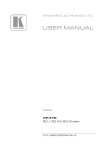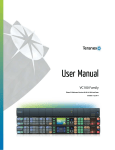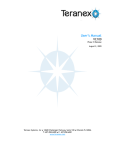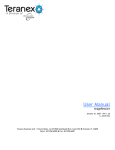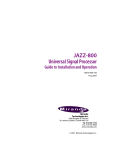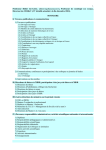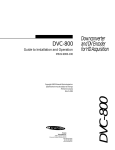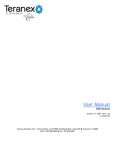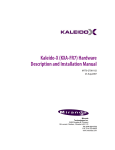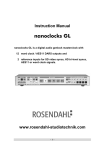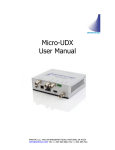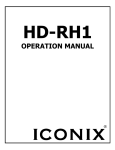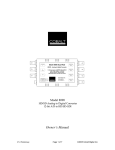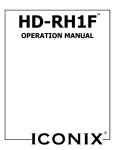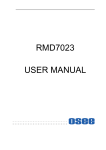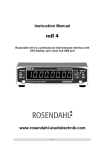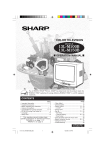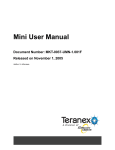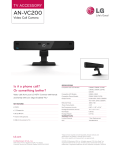Download User Manual - Dynamix Professional Video Systems
Transcript
User Manual imageConvert January 16, 2007 – Rev 1.2d S. Ackerman Teranex Business Unit / Silicon Optix, Inc 7800 Southland Blvd, Suite 250 Orlando, FL 32809 Voice: 407.858.6000 Fax: 407.858.6001 Silicon Optix, Inc imageConvert User Manual Table of Contents USER MANUAL ............................................................................................................. 1 TABLE OF CONTENTS .................................................................................................... 2 PREFACE ................................................................................................................... 4 OVERVIEW.................................................................................................................. 5 Filters and Algorithms ................................................................................................. 5 Enhanced Conversion Decision List Processing.................................................................... 5 Formats .................................................................................................................. 6 Packages ................................................................................................................. 8 INSTALLING & STARTING................................................................................................ 9 Installing Application Software from CD ........................................................................... 9 Getting assistance ..................................................................................................... 9 Servicing ................................................................................................................. 9 GETTING STARTED WITH YOUR APPLICATION.....................................................................10 Automatic load of the factory-set Default Application......................................................... 10 START-UP MENU .........................................................................................................12 Application Keys....................................................................................................... 12 Upgrading Software from a CD...................................................................................... 14 Calibration of the Touchscreen..................................................................................... 14 Editing the System IP Address ...................................................................................... 15 System Information ................................................................................................... 15 APPLICATION INTERFACE ..............................................................................................17 Standard Display Layout for Application Interface – VC200 ................................................... 17 Standard Display Layout for Application Interface – VC300/VC600 .......................................... 18 Standard Platform Color Error Indications:....................................................................... 20 Input / Output Formats .............................................................................................. 21 Configuration .......................................................................................................... 22 Input Select ............................................................................................................ 23 Screenlock .............................................................................................................. 25 Presets .................................................................................................................. 26 User-defined Labeling for Presets – Example .................................................................... 28 Configuration .......................................................................................................... 28 Keyboard & Knob Interface.......................................................................................... 31 PROCESSING MENU ......................................................................................................33 Aspect Menu............................................................................................................ 34 Variable Aspect Control.............................................................................................. 36 Source Menu............................................................................................................ 38 Conversion Menu ...................................................................................................... 41 Proc Amp Control Menu .............................................................................................. 42 Colorspace Menu ...................................................................................................... 43 Custom Colorspace (VC300/VC600 Only).......................................................................... 45 Detail Enhance Menu ................................................................................................. 46 Noise Reduce - Master Menu ........................................................................................ 47 Adaptive Median “Spike” Filter..................................................................................... 49 Brickwall Filter ........................................................................................................ 50 Temporal Recursive Filter ........................................................................................... 52 SYSTEM SETUP MENU ...................................................................................................56 Input Video Menu – VC200 ........................................................................................... 57 Output Video Menu – VC200 ......................................................................................... 58 Reference............................................................................................................... 59 Audio .................................................................................................................... 60 Timecode ............................................................................................................... 61 GPI Menu................................................................................................................ 62 Knob & Display – VC200 .............................................................................................. 63 Copyright 2007 – Silicon Optix, Inc. – All rights reserved. 2 of 74 Silicon Optix, Inc imageConvert User Manual Power Menu – VC200 .................................................................................................. 64 Keyed Product Options ............................................................................................... 65 System Info ............................................................................................................. 66 Conversion Decision List ............................................................................................. 67 Conversion Decision List Menu ...................................................................................... 68 Exit ...................................................................................................................... 73 OK........................................................................................................................ 73 Copyright 2007 – Silicon Optix, Inc. – All rights reserved. 3 of 74 Silicon Optix, Inc imageConvert User Manual Preface Copyright © 2007 Silicon Optix Incorporated. All rights reserved. Printed in the United States of America All data and information contained in or disclosed by this document is confidential and proprietary information of Teranex Incorporated, and all rights therein are expressly reserved. By accepting this material the recipient agrees that this material and the information contained therein is held in confidence and in trust and will not be used, copied, reproduced in whole or in part, nor its contents revealed in any manner to others without the express written permission of Silicon Optix Incorporated. Information in this document is preliminary and subject to change and does not represent a commitment on the part of Silicon Optix Incorporated. Version 1.0 1.1 1.2d 1.3 1.4 1.5 Date 2005.xx.xx 2006.01.31 2007.01.16 Comment Draft Release Initial Release By S. Ackerman S. Ackerman S. Ackerman References: imageConvert_UM.doc Copyright 2007 – Silicon Optix, Inc. – All rights reserved. 4 of 74 Silicon Optix, Inc imageConvert User Manual Overview Filters and Algorithms PixelMotion™ De-interlacing PixelMotion de-interlacing of video originated material produces perfect progressive frames in preparation for further processing. The processing aperture is adjusted on a pixel-by-pixel basis, which preserves all of the detail of the original interlaced image and eliminates jaggies in the output image. Scene Change Detection Preserves clean cuts between scenes. Upon detecting a cut, the temporal aperture is reduced from 4fields to 2-fields for the first frame in the new scene. This prevents uncorrelated data from being used in the interpolation process at scene boundaries. Colorspace Conversion Is required on format conversion due to the differing color primaries and luma equations of the existing standards. Aspect Ratio Control Allows selection from standard aspect ratios such as common top & bottom, common sides and anamorphic. Once selected, each aspect ratio offers adjustments for horizontal and vertical image resizing, pan & tilt and position. Detail Enhancement Is an edge-sharpening filter based on a traditional film compositing technique called "Unsharp Masking." This filter corrects any blurring introduced during image capture, compression or resampling. Timecode & Audio Handling Proper handling of audio and time code ensures that synchronization is maintained throughout the processing cycle. Enhanced Conversion Decision List Processing Easy-to-use controls capture all processing parameters based on time code allowing processing parameters to be fine-tuned on a scene-by-scene basis. These parameters are then applied on a frame accurate basis to the source material. Copyright 2007 – Silicon Optix, Inc. – All rights reserved. 5 of 74 Silicon Optix, Inc imageConvert User Manual Formats The imageConvert family of applications supports the following formats X4-FC-2 Multi-Format Conversion Package Minimum Platform Requirement – VC300, 2-board system Input 480i59.94 480sf29.97 480p59.94 576i50 576p50 720p23.98 Output 480i59.94 480sf29.97 480p59.94 576i50 576sf25 720p23.98 720p59.94 1080i50 1080i59.94 1080p23.98 1080sf23.98 1080sf25 480p59.94 720p59.94 1080i59.94 480i59.94 480i59.94 576i50 576sf25 576p50 720p50 720p59.94 1080i50 1080i59.94 1080sf23.98 1080p24 1080sf24 1080sf25 576i50 480i59.94 720p23.98 720p59.94 1080i59.94 1080p23.98 1080sf23.98 Input 720p50 720p59.94 1035i59.94 1080i50 1080i59.94 Copyright 2007 – Silicon Optix, Inc. – All rights reserved. Output 576i50 720p50 720p59.94 1080i50 480i59.94 576i50 720p50 720p59.94 1080i50 1080i59.94 1080p23.98 1080sf23.98 108sf29.98 480i59.94 480i59.94 576i50 720p50 720p59.94 1080i50 1080i59.94 1080p24 1080sf24 1080sf25 480i59.94 576i50 720p23.98 720p59.94 1080i50 1080i59.94 1080p23.98 1080sf23.98 1080sf25sf 1080p29.97 1080sf29.97 Input 1080p23.98 1080sf23.98 1080p24 1080p24sf 1080p24sf 1080p25 1080sf25 Output 480i59.94 720p23.98 720p59.94 1080i59.94 1080p23.98 1080sf23.98 480i59.94 720p23.98 720p59.94 1080i59.94 1080p23.98 1080sf23.98 1080sf25 480i59.94 576i50 720p59.94 1080i50 1080i59.94 1080sf25 576i50 1080i50 1080p25sf 576i50 480i59.94 576i50 576sf25 1080i50 1080i59.94 1080sf23.98 1080p24 1080sf24 1080sf25 6 of 74 Silicon Optix, Inc imageConvert User Manual X4-FC-1 Multi-Format Conversion Package Minimum Platform Requirement – VC200, 1-board system Input 480i59.94 480sf29.97 480p59.94 576i50 Output 480i59.94 480sf29.97 480p59.94 576i50 576sf25 720p23.98 720p59.94 1080i50 1080i59.94 1080p23.98 1080sf23.98 1080sf25 480p59.94 720p59.94 1080i59.94 480i59.94 480i59.94 576i50 576sf25 Input 576i50 576p50 720p23.98 720p50 Output 576p50 720p50 720p59.94 1080i50 1080i59.94 1080sf23.98 1080p24 1080sf24 1080sf25 576i50 480i59.94 720p23.98 720p59.94 1080p23.98 1080sf23.98 576i50 720p50 720p59.94 1080i50 Input 720p59.94 1035i59.94 1080i50 1080i59.94 1080sf23.98 1080p25 1080sf25 Output 480i59.94 576i50 720p50 720p59.94 1080i59.94 1080sf29.98 480i59.94 480i59.94 576i50 720p50 480i59.94 576i50 720p59.94 480i59.94 576i50 480i59.94 576i50 576sf25 X4-SP-1 Slow PAL Conversion Package Minimum Platform Requirement – VC300, 1-board system Input 480i59.94 576i48 Output 576sf23.98 480i59.94 720p23.98 720p59.94 1080i59.94 1080p23.98 Input 576i48 576sf23.98 Copyright 2007 – Silicon Optix, Inc. – All rights reserved. Output 1080sf23.98 480i59.94 576sf23.98 720p23.98 720p59.94 1080i59.94 Input 576sf23.98 720p23.98 1080i59.94 1080p23.98 1080sf23.98 Output 1080p23.98 1080sf23.98 576sf23.98 576sf23.98 576sf23.98 576sf23.98 7 of 74 Silicon Optix, Inc imageConvert User Manual Packages The imageConvert families of applications are available in the following configurations X4-FC-2 imageConvert – Multi-Format Converter Software Includes all of X4-FC-1 below plus HD Standards Conversion (HD-FRC), Cross Conversion with Frame Rate Conversion (FRC) and HD 3:2 Insert/Delete X4-FC-1 ImageConvert – Multi-Format Converter Software Includes: Up with Advanced Noise Reduction, Up/Down/Cross, Up/Down with Frame Rate Conversion (FRC), SD Linear Standards Conversion, SD 3:2 Insert/Delete, Variable Aspect Ratio Conversion, Colorspace Conversion, and Detail Enhance. imageConvert – Slow PAL Converter Software Includes: Slow PAL conversion, Variable Aspect Ratio Conversion, Colorspace Conversion, and Detail Enhance. NOTE: Requires a Slow PAL hardware modification kit X4-SP-1 Copyright 2007 – Silicon Optix, Inc. – All rights reserved. 8 of 74 Silicon Optix, Inc imageConvert User Manual Installing & Starting Installing Application Software from CD Teranex Video platforms come pre-loaded with your purchased application software. However, if the need arises to install new or upgrade old application software, loading software from CD may be required. Please refer to the “Teranex Video Computer Installation and User Manual” section on upgrading from CD if you need to install software. Getting assistance This manual will help you get started with your Teranex application. features and procedures for the tasks you can perform using this product. It provides an overview of However, if you need further assistance please contact: 24-hr Technical Support Phone: For US & Canada: International: 877.2.TERANEX (877.283.7263) 1.407.858.6000 Technical Support e-mail: [email protected] Technical Support web site: www.teranex.com/support Servicing Only authorized service personnel should open the unit. supply(ies) before servicing. Copyright 2007 – Silicon Optix, Inc. – All rights reserved. Disconnect AC sources to the power 9 of 74 Silicon Optix, Inc imageConvert User Manual Getting started with your application Automatic load of the factory-set Default Application Your system has been shipped with one of the Teranex software applications selected as a default to automatically start at power-on. The following describes the power-on & start up sequence for the Teranex Video Computer. The user will only see two screens while the system is starting; after which the app is ready to use. Power-On & Start Up Sequence: Figure 1: VC200 Figure 2: VC300/VC600 1st Screen – Autoload - During the power-on & start up sequence, the Autoload display screen will be in view for 5 seconds. DO NOT TOUCH THE SCREEN if you want the system to load the default app. However, if you want to change from your current defaulted application and select another Teranex software application, then press the “Press To Cancel Autoload” button. This will take you to the Start-Up menu where you can select your desired application or select a new default application. See the “Setting the Default Application” section for instructions on how to set a new default application. Copyright 2007 – Silicon Optix, Inc. – All rights reserved. 10 of 74 Silicon Optix, Inc imageConvert User Manual Figure 3: VC200 Figure 4: VC300/VC600 2nd Screen – Application Screen – If you allowed the system to load the default application; the system will then bring up that application’s Main Splash Screen. Your application is then ready to use. Copyright 2007 – Silicon Optix, Inc. – All rights reserved. 11 of 74 Silicon Optix, Inc imageConvert User Manual Start-Up Menu The Start-up Menu is shown if the “Press to Cancel Autoload” button is pressed on the Autoload screen, or if you exit the current application. The Start-up Menu is shown below: Figure 5 - VC200 Figure 6 - VC300/VC600 From this screen a number of things can be done: • Run a selected Application • Edit the software key for an application • Delete a software key • Upgrade the system from a CD • Calibrate the touch screen • Edit the IP address of the system • Get system information Application Keys The scrolling list of application keys on the left side of the screen allows up to 12 applications to be started from this screen. Since some application features are optional it is possible to create two or more buttons for the same basic application, but each button may invoke a software key that enables different application options. Running an Application To run an application from the scrolling list, select the button by pressing on it, and then press the Run key. Copyright 2007 – Silicon Optix, Inc. – All rights reserved. 12 of 74 Silicon Optix, Inc imageConvert User Manual Editing Application Keys To enter a new application key or modify an existing key, select the application button and press the “Edit Key” button. This will bring up a screen where both the key name and the key itself can be entered. Figure 7: VC200 Figure 8: VC300/VC600 Enter in the desired name for the key and the 16-character key for the application and press the “OK” button. Normally software keys are sent out via email or mail and contain a space after every four characters for legibility reasons. When entering the key into the system do not include the spaces. Key names can be a maximum of 6 characters long. Deleting Application Keys To delete an application key, simply select the button to be removed and press the “Delete Key” button. Setting the Default Application One application on the system can be set to automatically start if the “Press to Cancel Autoload” button is not pressed. This default application is selected by choosing the small circular button next to the desired application. A small pop-up window will appear and ask that you confirm that this is the choice for the default application. After pressing “Yes”, this application will now become the default application. Copyright 2007 – Silicon Optix, Inc. – All rights reserved. 13 of 74 Silicon Optix, Inc imageConvert User Manual Upgrading Software from a CD Upgrades to the system software are distributed on CD-ROMs. To upgrade the software, place the CDROM into the CD-ROM drive and make sure that this drive is connected to the system. For the VC600 chassis, a CD-ROM drive is inside the chassis on the right hand side. Simply swing open the front bezel of the system after loosening the four captive screws and place the CD-ROM into the drive. Wait for a few seconds while the drive and system recognize that a disk has been installed and then the upgrade process can begin. For the VC300 and VC200 systems, an external USB-based CD-ROM must be used. It is possible to connect the external CD-ROM drive to the system while it is powered up, but the system must be powered off, then on again, before it will recognize that the CD-ROM drive is connected to the system. Once the system is up and at the Start-Up Menu again, the upgrade process can begin. Click on the “Upgrade From CD” button to start the upgrade process. You will have three options at this point – upgrade and write over any existing presets, upgrade and save any existing presets, or cancel the upgrade process – as shown in the illustrations below. Figure 9: VC200 Figure 10: VC300/VC600 Calibration of the Touchscreen Pressing the “Calibrate Touch Screen” button will launch a series of menus where cross-hairs will appear in each of the four corners of the touch screen. Press on the center of each cross hair and the next one will appear. After the four in the corners are finished, a cross hair will appear at the center of the screen. Press this cross hair to complete the calibration process. Copyright 2007 – Silicon Optix, Inc. – All rights reserved. 14 of 74 Silicon Optix, Inc imageConvert User Manual Editing the System IP Address The system can be controlled via a remote control application by using the Ethernet connection. To do this, an IP address must be defined for the system. The system must have a static IP address set for it, it will not automatically configure an IP address on networks with DHCP servers. To edit the IP address, press the “Edit IP Address” button. The following screen will appear: Figure 11: VC200 Figure 12: VC300/VC600 When shipped from the factory, the default IP address for VC200 systems shipped is: 192.168.88.84. For the VC300 and VC600 systems, the default IP address is 192.168.88.152 For proper operation of the system on a Local Area Network, the subnet mask of the Local Area Network must be 255.255.255.0. System Information Pressing the “System Info” button will cause the System Info screen to appear: Figure 13: VC200 Figure 14: VC300/VC600 Copyright 2007 – Silicon Optix, Inc. – All rights reserved. 15 of 74 Silicon Optix, Inc imageConvert User Manual This menu shows the software version of the major applications on the system as well as the IP address and the MAC address. The IP address (as set in “Editing the System IP Address” on page 12) is important to know for establishing a network connection to the system. The MAC address is also a networking parameter that is not normally referenced, but is important for the system because the keys that unlock the software on the system are based on this number. Should additional software applications or options be ordered for the system, you may be asked to confirm the last four characters of the MAC Address. This is one of the two places where this can be seen. The other is in the System Setup Menu – see “System Info” on page 12 for this. Copyright 2007 – Silicon Optix, Inc. – All rights reserved. 16 of 74 Silicon Optix, Inc imageConvert User Manual Application Interface This chapter describes the display screen layouts & functionality that are standard for Teranex applications. With this standard, the user can expect a common user-interface, with an intuitive, userfriendly application interface when using the imageConvert applications. Standard Display Layout for Application Interface – VC200 Area 1 Area 2 Area 4 Area 3 Figure 15: VC200 The touchscreen is divided into four functional areas. Area 2 will be the area to find application specific menus. Area 2, 3 and 4 are common for all software applications. The touch screen is divided into four functional areas: Area 1 – The first area is the general splash area. This area is used to display the various processing menus Area 2 - The second area of the display is used to show the currently selected input format and type. This area will also shown diagnostic information if the input is lost or incorrect. Area 3 - The third area contains the buttons used to access the various system menus • • • • • • • • System Setup Screen Lock Formats Processing CDL System Info Presets Exit Area 4 - The second area of the display is used to show the currently selected output format and type Copyright 2007 – Silicon Optix, Inc. – All rights reserved. 17 of 74 Silicon Optix, Inc imageConvert User Manual Standard Display Layout for Application Interface – VC300/VC600 The touchscreen is divided into four functional areas. Area 2 will be the area to find application specific menus. Area 1, 3 and 4 are common for all software applications. The screen below shows a generic screen layout. Area 1 Area 2 Area 3 Area 4 Figure 16: VC300/VC600 Area 1 – Presets - The Preset function provides the user a way to save or recall parameter settings to and from memory. Area 2 – App Menu – This area of the display (the area below the presets) is used to display the various menus for any Teranex software application the user selects. Area 3 - The third area, shown below, contains the System Setup Button, Screen Lock Button and Status Indication Area Displays. (a) (b) (c) (d) (e) (f) (g) (h) Area 3 - Soft Keys (a) System Setup - Opens the Setup Menu The Setup Menu allows the user to verify installed options, setup GPI’s, choose the Genlock Reference Source, and perform other basic setup functions. Details on the Setup Menu can be found further on in the document. (b) Screen Lock - Opens the Screen Lock Menu See the Screenlock section for a description of this function. Copyright 2007 – Silicon Optix, Inc. – All rights reserved. 18 of 74 Silicon Optix, Inc imageConvert User Manual (c) Status Indication Area – (c through h) the status area (see above) has a text display for each of the processing menus/options. Normally these text displays will be gray. If a change is made to one of the menus, causing the unit to be in a non-standard mode, the text will be shown in yellow. Depending on the configuration of the system purchased, pressing on the text displayed in status indication bar will cause the corresponding processing menu to be displayed in Area 2 of the touchscreen. Area 4 – The Main Control buttons are located in the lower portion of the display screen. There are 4 main control buttons and two programmable Rotary Knobs (left/right for the VC600 Video Computer and top/bottom for the VC300 Video Computer). Copyright 2007 – Silicon Optix, Inc. – All rights reserved. 19 of 74 Silicon Optix, Inc imageConvert User Manual Standard Platform Color Error Indications: There are four colors use to indicate system active or errors. The colors utilized are: gray, green, yellow and red. The colors have the following meanings: Input Select Button (System Setup Menu – VC200) • GRAY - An input is selected and valid • GREEN – Not Applicable • YELLOW - If the input select button is yellow, then the unit has detected an input signal, but it is not valid based on the currently selected input. • RED - Indicates that no input has been detected Reference Tab (System Setup Menu) • GRAY – A reference input is selected and valid • GREEN – Not Applicable • YELLOW - If the input select button is yellow, then the unit has detected an input signal, but it is not valid based on the currently selected reference source. • RED - Indicates that no reference input has been detected Audio • • • Tab (System Setup Menu) GRAY - An audio input is selected and valid GREEN – Not Applicable YELLOW - If the input select button is yellow, then the unit has detected an input signal, but it is not valid based on the currently selected audio input. • RED - Indicates that no audio input has been detected User Presets (System Setup Menu – VC200) • GRAY – Indicated that the preset is not active • GREEN – Indicates that the preset is active • YELLOW - If changes have been made to the system after the preset has been selected, then the Preset button will show yellow. • RED – Not Applicable Copyright 2007 – Silicon Optix, Inc. – All rights reserved. 20 of 74 Silicon Optix, Inc imageConvert User Manual Input / Output Formats Input Format – Pressing the Formats button on the VC200 or the Input or Output buttons on the VC300/VC600, opens a menu, which allows the user to set the desired formats. The Input Format slider and selection buttons are located in the left column. Figure 17: VC200 Figure 18: VC300/VC600 Output Format – Pressing the Formats button on the VC200 or the Input or Output buttons on the VC300/VC600, opens a menu, which allows the user to set the desired formats. The Output Format slider and selector buttons are located in the center column. Figure 19: VC200 Figure 20: VC300/VC600 Copyright 2007 – Silicon Optix, Inc. – All rights reserved. 21 of 74 Silicon Optix, Inc imageConvert User Manual Configuration Configuration allows the users to access different applications within a given product family without having to exit the current application. The Configuration buttons are located on the right, topside. Configuration button definitions follow: STANDARD – The system is in a normal mode with all features under the PROCESSING/SOURCE menu enabled. Please note that some buttons will be grayed out in this menu for certain conversions. Please note that this may not be the best mode for normal broadcast use – see ‘BROADCAST MODE’ below. CLEAN CADENCE - This is an optimized film processing mode for applications or situations when the input 3:2 sequence must be corrected on the ImageConvert output. The system, being in an optimized FILM PROCESSING mode, will have only film mode enabled as a source. The system is locked into film 3:2 removal/insertion using INPUT CADENCE CORRECTION. In this mode, cadence correction will be performed if necessary. MAINTAIN CADENCE – This is an optimized film processing mode for Telecine applications or situations when input 3:2 sequences must be maintained, or passed through, on the ImageConvert output. The system, being in an optimized FILM PROCESSING mode, will have only film mode enabled as a source. The system is locked onto film 3:2 removal/insertion using INPUT CADENCE PASSTHROUGH. In this mode, no cadence correction will be performed. BROADCAST – Specifically for broadcast ‘set and forget’ applications or situations when content is mixed and unpredictable. The Teranex system is essentially placed in ‘video’ mode on the SOURCE menu. This allows film, video, and mixed film/video (such as a video CG crawl over film) to pass through the Teranex with no disturbances. Copyright 2007 – Silicon Optix, Inc. – All rights reserved. 22 of 74 Silicon Optix, Inc imageConvert User Manual Input Select Pressing this button will open a menu that will show the currently selected input. Once an input is selected, the button will indicate the active input (e.g. HD-A, HD-B, etc.). Figure 21: VC200 Figure 22: VC300/VC600 Note: The Input Video selection menu on the VC200 Video Computer is located under the System Setup menu. Serial Digital Inputs (Note: only 2 physical inputs are present on the VC200 and VC300 P4 Video Computers. These 2 inputs will accept either HD-SDI or SD-SDI based on the conversion selected) SD-A – Selects standard definition, SDI input A (Physical input A) SD-B – Selects standard definition, SDI input B (Physical input B) HD-A – Selects high definition, HD-SDI input A (Physical input A) HD-B – Selects high definition, HD-SDI input B (Physical input B) The VC200 Input Video menu as shown above is also used to select an analog video input. For information about selecting analog inputs on the VC200, consult the Input Video menu in the System Setup Menu section of this manual. Copyright 2007 – Silicon Optix, Inc. – All rights reserved. 23 of 74 Silicon Optix, Inc imageConvert User Manual The color of the Input Select button VC300/VC600) will indicate the status of that input. The Input Format button on the main splash will also change color based on the conditions listed below. HD-A GRAY - an input is present and valid. Input Input Select Select HD-A YELLOW - the unit has detected an input signal, but it Is not valid based on the currently selected input format. Input Input Select Select HD-A HD-A RED - indicates that no input has been detected. Input Input Select Select Note: Buttons are located under the ‘INPUT SELECT’ button on the main VC300 splash screen. Note: On the VC200 splash screen, the input readout is located as input (and output) format text positioned on the left (input) and right (output) splash screen area. The Input Format text will change color based on the conditions listed above. The System Setup button on the lower far left will change color to reflect the ‘Input Select’ status within that menu Copyright 2007 – Silicon Optix, Inc. – All rights reserved. 24 of 74 Silicon Optix, Inc imageConvert User Manual Screenlock Figure 23: VC200 Figure 24: VC300/VC600 The Screen Lock menu disables touchscreen control, preventing changes to system operational parameters. Press “Cancel” if you wish to cancel this operation. This feature allows for an OPTIONAL password to be set to prevent unauthorized access. If you want to lock the screen to prevent accidental changes in parameters, simply press the screen lock button. The Screen Lock Keyboard will then be displayed. The user can then either click “OK” to lock the screen without entering a password, or enter a password and click “OK”. The normal splash screen will appear with the word “LOCKED” in the background as shown below. Setting a password provides the user with additional security. To unlock the system, touching anywhere on the screen will bring up the keyboard. Use the touchscreen keyboard to enter a password up to nine-characters in length. Setting a password provides the user with additional security. Note: If a password is used, please be sure to record the password in safe place, in case the password is forgotten. Also, a power cycle will clear the password. Figure 25: VC200 Figure 26: VC300/VC600 Copyright 2007 – Silicon Optix, Inc. – All rights reserved. 25 of 74 Silicon Optix, Inc imageConvert User Manual Presets The Preset function provides the user a way to save or recall processing parameter settings to memory. On the VC300/VC600 these presets are located in a drop-down menu that is keyed-off of the upper left-most button (the one with the arrow). On the VC200, the presets can be accessed from the Presets button on the main screen. There are a total of 41 presets, 40 user and 1 master, that can be used in this system. The user presets are setup in 8 groups (Sets) of 5 presets. The master preset is called ‘Store Current’ and, when saved, becomes the power-on default common to all Teranex systems. There are three reasons it is important to save the user-defined parameter settings: • Parameter settings are needed for future use • In case of power failure • In situations requiring system restart Presets – VC200 Figure 27: VC200 Store Preset – Will store the current system setup in the selected Set and Preset. For example pressing Store Preset in the GUI image above would save Preset 1 of Set 1. Recall Preset – Will load the stored setting of the currently selected Set/Preset. Rename Preset – Will allow the user to name the current Set / Preset. Dismiss – Returns the user to the main screen. Copyright 2007 – Silicon Optix, Inc. – All rights reserved. 26 of 74 Silicon Optix, Inc imageConvert User Manual Figure 28: VC200 Presets – VC300/VC600 Figure 29: VC300/VC600 Location of Preset drop-down menu Along the top of the display are five preset buttons and one Set selection button. • The drop-down menu will display a list of 8 User groups – Set 1 through Set 8. • Each group has five user definable presets – Presets 1 through Preset 5. • The extra (1) Master Preset called “Store Current” is just above the CDL Marking button at the bottom of the drop down menu. This stores the current settings for power-on default. Copyright 2007 – Silicon Optix, Inc. – All rights reserved. 27 of 74 Silicon Optix, Inc imageConvert User Manual User-defined Labeling for Presets – Example Each of the group Sets and the individual Presets can be edited and renamed with a user-defined label. The table below shows and example of presets with user defined names: Film 1 Interior Ext Day Ext Nite PRESET 4 PRESET 5 Film 2 PRESET 1 PRESET 2 PRESET 3 PRESET 4 PRESET 5 HD 3 PRESET 1 PRESET 2 PRESET 3 PRESET 4 PRESET 5 SET 4 PRESET 1 PRESET 2 PRESET 3 PRESET 4 PRESET 5 SET 5 PRESET 1 PRESET 2 PRESET 3 PRESET 4 PRESET 5 SET 6 PRESET 1 PRESET 2 PRESET 3 PRESET 4 PRESET 5 SET 7 PRESET 1 PRESET 2 PRESET 3 PRESET 4 PRESET 5 SET 8 PRESET 1 PRESET 2 PRESET 3 PRESET 4 PRESET 5 Store Current Configuration The Store Current preset allows the user to store a system configuration that will be used if the system looses power or is restarted. To Store the Current Settings and Configuration: • Press the gray “Set” button at the top left of the display to open the pull down User Set menu. (See illustration below.) • At the bottom of the User Set pick list, press the button labeled “Store Current” to save the current state of the Video Platform configuration. • The current configuration will now be restored if power is turned off or if power is accidentally lost to the unit. Figure 30: VC300/VC600 Copyright 2007 – Silicon Optix, Inc. – All rights reserved. 28 of 74 Silicon Optix, Inc imageConvert User Manual Save, Recall or Rename a Preset To access the User Presets, press the Presets button (top left). Pressing the button will expose a list of 8 User groups. Each group has five user definable presets, yielding a total of 40 user presets. Figure 31: VC300/VC600 To Save a User Preset: • Press the Set button at the top left of the display to open the pull down User Set list. • Select the Set from 1 - 8 into which you would like to save the current configuration • Select the specific User Preset button (1 - 5) to which you’d like to save the current. • A pull down menu will be displayed (see above) with the options to Store, Recall or Rename the selected preset button. • Select Save. To Recall a User Preset: • Press the Set button at the top left of the display to open the pull down User Set list. • Select the Set from 1-8 from which you would like to recall a configuration. • Select the specific User Preset button (1 - 5) that holds the configuration you would like to recall. • A pull down menu will be displayed (see above) with the options to Store, Recall or Rename the selected preset button. • Select Recall. • When the preset is selected the corresponding button will change to green to show that the preset is active. • If any changes are made to the system after a preset has been selected the Preset button will show Yellow. Copyright 2007 – Silicon Optix, Inc. – All rights reserved. 29 of 74 Silicon Optix, Inc imageConvert User Manual To Rename a User Preset: • Press the Set button at the top left of the display to open the pull down User Set list. • Select the Set from 1-8, which you would like to rename. • Select the User Preset button (1 - 5), which you would like to rename. • A pull down menu will be displayed (see above) with the options to Store, Recall or Rename the selected preset button. • Select Rename. • After selecting Rename, the “Rename a Preset” screen and keyboard will be displayed. Using the keyboard, type in the new name for the Preset button and press “OK”. To Rename a User Set: • Press the Set button at the top left of the display to open the pull down User Set list. • Select the Set from 1-8 that you’d like to rename. This makes the set that you’d like to rename the active Set. • Again, press the Set button at the top left of the display to open the pull down User Set list. • Select Rename. • After selecting Rename, the “Rename a Preset” screen and keyboard will be displayed. Using the keyboard, type in the new name for the Set button and press “OK.” Copyright 2007 – Silicon Optix, Inc. – All rights reserved. 30 of 74 Silicon Optix, Inc imageConvert User Manual Keyboard & Knob Interface Keyboard Interface Figure 32: VC200 Figure 33: VC300/VC600 Within the platform is a keyboard display. This keyboard is utilized to enter Passwords when using Screen Lock, renaming presets and entering new software keys in the Startup Menu to enable use of new Teranex Software Applications. Knob Interface There is one programmable knob on the front panel of the VC200 Video Computer and two programmable knobs on the front panel of the VC300 & VC600 Video Computers. These knobs are rotary encoders and are useful when the touchscreen “sliders” do not provide the fine control desired by the operator. Figure 34: VC200 Figure 35: VC300/VC600 Copyright 2007 – Silicon Optix, Inc. – All rights reserved. 31 of 74 Silicon Optix, Inc imageConvert User Manual Programming the knobs The operational mode of each knob can be set independently. There are three modes that are selectable via the pull-down menus activated by pressing the Left Knob or Right Knob Buttons: Knobs can be programmed in the following modes: • Deprogrammed – The knob is disabled. • Follow Mode – The knob can be assigned ‘on the fly.’ When the user activates a slider control by touch within one of the menus and then turns a knob, the knob is automatically assigned to that function, or ‘follows’ the operator. When the user selects another slider control and turns the knob, the knob will be re-assigned to the new function. • Assigned – Locks a knob to a particular function (e.g.- Proc Amp Video Level). The knob retains this function even when the GUI screen is changed to another mode. To assign a function to a knob, activate the desired slider and then select the “Assigned” mode for the desired knob. The knob will continue to control only this function until the knob is reassigned to Follow Mode or Deprogrammed. Note: On the VC200 chassis access to the knob menu is made by first going to the System Setup menu, then selecting the “Knob & Display” tab. This menu also controls the brightness of the display on the VC200. Refer to the System Setup Menu section of this manual for a description of this capability. Physical Knob Location for VC600 vs. VC300 systems: • On the VC600 Video Computer, the physical location of the rotary knobs is below the touchscreen display, and are referred to as “Left Knob” and “Right Knob” in the GUI. • On the VC300 Video Computers the physical location of the rotary knobs are to the right of the touchscreen display, and are referred to as “Top Knob” and “Bottom Knob” in the GUI. Copyright 2007 – Silicon Optix, Inc. – All rights reserved. 32 of 74 Silicon Optix, Inc imageConvert User Manual Processing Menu The Processing Menu is selected by pressing the Processing button. The Processing menu is arranged in a tab control layout in Area 2 of the touchscreen, as shown below. Each menu is selected by pressing the appropriate tab for the function desired along the top of the menu. Figure 36: VC200 Figure 37: VC300/VC600 Processing – Pressing this button opens a menu in Area 2 - as shown below - that allows the user to access the following processing menus for the imageConvert applications: • • • • • • • Aspect Ratio Conversion Source Type Conversion Method Proc Amp Control Colorspace Conversion Detail Enhance Noise Reduction Copyright 2007 – Silicon Optix, Inc. – All rights reserved. 33 of 74 Silicon Optix, Inc imageConvert User Manual Aspect Menu Press the Aspect tab to reveal the menu below: Figure 38: VC200 Figure 39: VC300/VC600 Default Aspect Ratio Options: The Aspect Ratio menu offers the following default conversion options: Common Top and Bottom - Ensures that the top and bottom edges of the input image match the top and bottom edges of the output aspect ratio. For example, if the input aspect ratio were 4:3 and it was passed on to a 16:9 display using the common top and bottom method, the original 4:3 image would appear centered in the 16:9 display with black bars, or pillars, on the left and right side. Common Left and Right - Ensures that the left and right edges of the input image match the left and right edge of the output aspect ratio. For example, if the input aspect ratio is 4:3 and the output aspect ratio is 16:9, the left and right edges of the input image are stretched to match the left and right edges of the output. In order to maintain correct geometry of the image, the input image is then stretched vertically as well. This has the same result as zooming in on the image. While this method maintains correct geometry and fills the entire output display, it also results in an overall lose of approximately 33.33% of the input information in the vertical domain. This loss of information is split evenly between the top and bottom of the image. Anamorphic – This mode is similar to common top and bottom in that it ensures that the top and bottom edges of the input aspect ratio match the top and bottom edges of the output aspect ratio. It also, however, stretches the image horizontally to fill the output 16:9 aspect ratio. This mode is designed for use with material that was originally captured with an anamorphic lens, thereby generating an output image with correct geometry when stretched horizontally to 16:9. When used with standard 4:3 material, it will have the effect of stretching the material horizontally causing circles to appear as ovals, etc. Flexview – (Available in 480i to 720p59.94/1080i59.94 and 576i to 720p50/1080i50) This aspect is unique to Teranex. Flexview is a non-linear anamorphic aspect designed for converting 4:3 material to 16:9 without the traditional stretched and ‘fat’ distortion of a normal anamorphic stretch. Flexview leaves the center portion of the image normal but provides increasing amounts of stretch on either side, filling the 16:9 display without distorting the center action area. Flexview appears as a ‘wide angle’ effect and many viewers will perceive this as true HD. Copyright 2007 – Silicon Optix, Inc. – All rights reserved. 34 of 74 Silicon Optix, Inc imageConvert User Manual Variable Aspect Control – Activates the Variable Aspect Control screen when pressed. (See section below.) Note: Variable aspect ratio conversion may not be available in all format conversions, especially HD to HD. • Zoom/Crop – This function, when selected, will zoom the image by 3-pixels and then crop the image by 3-pixels. This purpose of this function is to allow video disturbances that may arise on the top or bottom edge of an image or on the left or right side of an image to be corrected. • Exit Variable Aspect – Replaces the Zoom/Crop button when the Variable Aspect Control mode is activated. This button will be Yellow and is used to exit the variable aspect ratio conversion mode. Pressing this button will cancel any changes made on the Variable Aspect Ratio menu. Other Controls: Edge Trim – This control adjusts the amount of border cropping that is performed on the image in common top & bottom aspect ration mode. It is adjustable from 0-to-50 or 0-to-20 pixels, depending on the conversion currently in use. To adjust, move the slider up or down, or press on the horizontal bars above or below the slider to change the setting by increments of 2. This control may also be assigned to a front panel knob. Fill Shade – When the input aspect ratio is smaller than the output aspect ratio and no stretching or zooming is performed, there are areas in the output display device that are filled with “black.” The Fill Shade control adjusts the level of gray of these areas from 64 (digital black) to 940 (digital white.) Move the slider up or down, or press on the horizontal bars above or below the slider to change the setting by increments of 1. This control may also be assigned to a front panel knob. • Pan Control – Adjusts the position of the input image window in aspect ratios where part of the image is cropped. Note: The status Icon in the Input and Output format buttons will change to show the selected aspect ratios. Note: The dotted line visible in the status icon shows the area of the input signal that will be cut off by going to the currently selected output aspect ratio. Note: Circles in the icons will show any geometric distortion that will occur with the currently selected aspect ratio. Copyright 2007 – Silicon Optix, Inc. – All rights reserved. 35 of 74 Silicon Optix, Inc imageConvert User Manual Variable Aspect Control On the VC300/VC600 the control screen below will be displayed, providing horizontal and vertical sizing controls: Zoom Y Slider – adjusts the vertical size of the image Link – ties the X and Y Zoom sliders together. The Y slider will control. Zoom X Slider – adjusts the horizontal size of the image. Nominal – returns the horizontal size to the default position Fill Color, Luminance Slider – changes the luminance level of the mask. Fill Color, Cb Slider – changes the Cb (blue) value of the mask. V Trim Arrow Buttons – allows the image mask to be trimmed in the vertical domain Fill Color, Cr Slider – changes the Cr (red) values of the mask Chroma Active – Pressing button toggles the Cr/Cb values of the image mask on and off Nominal Button returns the Tilt control to its default position Tilt Slider - If an image is resized in the vertical domain to a point where it is larger than the output window, portions of the image will not be visible. The Tilt slider allows the user to move the image in the output window, thus deciding which portion of the image is viewable. Zero Button – returns both the H and V trim controls to the default setting H Trim Arrow Buttons – allows the image mask to be trimmed in the horizontal domain Nominal – returns the vertical size to the default position. Dismiss – Exits the variable aspect ratio conversion menu. Changes made on the variable aspect menu will still be in effect once the menu has been dismissed. To cancel changes the user must press the ‘Exit Variable Aspect Button’ on the main Aspect Menu. V Position Arrow Buttons – allows vertical positioning of image Knobs – The Knobs located on the front of the Video Processing Platform are forced into “Follow Me” Mode when in the Variable Aspect Menu. Nominal Button – returns the Pan control to its default position. Copyright 2007 – Silicon Optix, Inc. – All rights reserved. Pan Slider – If an image is resized horizontally to a point where it is larger than the output window, portions of the image will not be visible. The Pan slider moves the image in the output window, thus deciding what portion of the image is viewable. X Position Arrow Buttons – allows horizontal positioning of image Zero Button – returns both H and V positions to the default setting 36 of 74 Silicon Optix, Inc imageConvert User Manual On the VC200, the control screen below will be displayed: Pan Slider – If an image is resized horizontally to a point where it is larger than the output window, portions of the image will not be visible. The Pan slider moves the image in the output window, thus deciding what portion of the image is viewable. Zoom X Slider – adjusts the horizontal size of the image. Tilt Slider - If an image is resized in the vertical domain to a point where it is larger than the output window, portions of the image will not be visible. The Tilt slider allows the user to move the image in the output window, thus deciding which portion of the image is viewable. Nominal – returns the horizontal size to the default position Fill Color, Cr Slider – changes the Cr (red) values of the mask Nominal – returns the vertical size to the default position. Fill Color, Luminance Slider – changes the luminance level of the mask. Nominal Button – returns the Pan control to its default position. Chroma Active – Pressing button toggles the Cr/Cb values of the image mask on and off Nominal Button returns the Tilt control to its default position Trim Y Arrow Buttons – allows the image mask to be trimmed in the vertical domain Trim X Arrow Buttons – allows the image mask to be trimmed in the horizontal domain Fill Color, Cb Slider – changes the Cb (blue) value of the mask. Zero Button – returns both the H and V trim controls to the default setting Y Position Arrow Buttons – allows vertical positioning of image Copyright 2007 – Silicon Optix, Inc. – All rights reserved. X Position Arrow Buttons – allows horizontal positioning of image Zero Button – returns both H and V positions to the default setting Dismiss – Exits the variable aspect ratio conversion menu. Changes made on the variable aspect menu will still be in effect once the menu has been dismissed. To cancel changes the user must press the ‘Exit Variable Aspect Button’ on the main Aspect Menu. 37 of 74 Silicon Optix, Inc imageConvert User Manual Source Menu Figure 40: VC200 Figure 41: VC300/VC600 Operation The Source Menu allows the user to define the type of material being input to the unit. Auto - Select this mode if the source material is a mixture of film and video. This mode selects a compromise algorithm that will look for film- and video-based material. For best results when the source material is known to be exclusively either film or video, select the Film or Video modes below. Film – Select this mode when the source material is film-originated. This mode will optimize the algorithms for processing film-originated material and will provide options for the various cadence issues associated with processing video recordings of film-originated material. (See Film Cadence Mode controls below.) Video – Select this mode if the source material is interlaced video material. This mode will optimize the algorithms for processing interlaced material. User Adjustable Parameters Film Mode (VC300/VC600 Only): Allows selection of Broken Cadence Mode, Video or Film Mode, Film over Film Mode, and Cadence Correction (Optional) Copyright 2007 – Silicon Optix, Inc. – All rights reserved. 38 of 74 Silicon Optix, Inc imageConvert User Manual Broken Cadence Mode – allows to application to be optimized for handling film-originated material that contains an inconsistent 3:2 sequence. It provides access to the user controls listed below: Figure 42: VC300/VC600 • Orphan Detection Aggressiveness – This control determines how hard the algorithm tries to make a match between an orphan field and its neighboring fields. At the low end of the control, the algorithm will do more interpolation, which means that an orphan field will be spatially up-sampled to create a progressive frame. The opposite end of the control causes the algorithm to work harder at trying to find a match with one of the neighboring fields. • Cut Detection Aggressiveness - This control sets how large a difference must be present in a scene change before it is interpreted as a “cut.” If the control were to be set too low, then simple actions such as a camera pan may be interpreted as a difference between frames and trigger the Cut Detector. Ideally, set the control at the higher end of the range so that only course changes between frames trigger the Cut Detector. • Post-Cut Manual Phase - When a cut occurs in the source material, the system must re-establish the 3:2 sequence after the cut. Depending on where the cut occurs, the new sequence after the cut may be starting on an A, B, C, or D frame. There may be cases where the system will get confused in selecting the correct new sequence. If this occurs, the Post Cut Manual Phase control allows the user to manually start the new sequence at the correct phase by bumping the phase to either an A, B, C, or D frame. • Disable Fade Detection – In most film-originated material, fades are achieved electronically in post-production, rather than performed optically in the film lab. Unfortunately, the process of creating a fade electronically disrupts the 3:2 sequence by causing a change in each field. The process of 3:2 detection, as seen above, occurs by matching fields back together that came from the same film frame. If, however, an electronic fade is applied, there will be a luminance difference in each field, thus making matches difficult. This will cause the system to treat the material as if it were video source material, and will interpolate the frames during the fade to prevent any artifacts from occurring. There may, however, be occasions when it is felt a better result would occur by allowing the system to continue to try to treat the material as film, thereby trying to match fields to create the progressive frames. The Disable Fade Detection mode allows the user to turn off fade detection so that the algorithm will continue to treat this material as film. Copyright 2007 – Silicon Optix, Inc. – All rights reserved. 39 of 74 Silicon Optix, Inc imageConvert User Manual Video Or Film – this mode optimizes the unit for use with material that is film-originated, but has 30frame video content overlaid. When this mode is selected, the following user controls are available: Figure 43: VC300/VC600 • Cadence Detection Aggressiveness - The effect of having 30-frame video information laid over film-originated material is that each field will now appear to be different. This difference can make the ability to detect the underlying 3:2 sequence more difficult, as no two fields will now match perfectly. The Cadence Detection Aggressiveness control determines how hard the algorithm will work at detecting the 3:2 sequence. At the low setting, the unit will do more interpolation or tend more towards treating the material as video. The opposite end will allow the algorithm the work harder at detecting the film sequence, thereby allowing it to treat the material as film more often. • Cut Detection Aggressiveness - This control sets how large a difference must be present in a scene change before it is interpreted as a “cut.” If the control were to be set too low, then simple actions such as a camera pan may be interpreted as a difference between frames and trigger the Cut Detector. Ideally, set the control at the higher end of the range so that only course changes between frames trigger the Cut Detector. • Disable Fade Detection – In most film-originated material, fades are achieved electronically in post-production, rather than performed optically in the film lab. Unfortunately, the process of creating a fade electronically disrupts the 3:2 sequence by causing a change in each field. The process of 3:2 detection, as seen above, occurs by matching fields back together that came from the same film frame. If, however, an electronic fade is applied, there will be a luminance difference in each field, thus making matches difficult. This will cause the system to treat the material as if it were video source material, and will interpolate the frames during the fade to prevent any artifacts from occurring. There may, however, be occasions when it is felt a better result would occur by allowing the system to continue to try to treat the material as film, thereby trying to match fields to create the progressive frames. The Disable Fade Detection mode allows the user to turn off fade detection so that the algorithm will continue to treat this material as film. Film Over Film – Not available in the imageConvert application Correct Cadence™ Mode – Not available in the imageConvert application Copyright 2007 – Silicon Optix, Inc. – All rights reserved. 40 of 74 Silicon Optix, Inc imageConvert User Manual Conversion Menu The Conversion Mode menu allows the user to select the appropriate method used for processing the input image. Figure 44: VC200 Figure 45: VC300/VC600 User Adjustable Controls Auto – Will always select the highest available processing mode. Linear Interpolation – De-interlaces the input image by throwing away one field of information from each frame and then re-samples the missing lines to match the output format. This method is simple to implement but results in a loss of ½ of the vertical detail. PixelMotion – De-interlaces the image by analyzing the image to determine if there is any inter-frame motion. If no motion is detected then the unit will use information from the entire frame. If, however, motion is present, then the unit resorts to a linear interpolation method. PixelComp TM – Not available in the imageConvert application Interpolation Aperture – Used when doing a frame rate conversion, the interpolation aperture is used to set the characteristics of the filter used to create the synthetics information in a frame rate conversion. A setting of 0 (drama) will give a sharper image with more potential for judder in motion areas. A setting of 16 (sport) will give a softer image with more blur in motion areas. PixelComp TM Aggressiveness – Not available in the imageConvert application Copyright 2007 – Silicon Optix, Inc. – All rights reserved. 41 of 74 Silicon Optix, Inc imageConvert User Manual Proc Amp Control Menu Press the Proc Amp tab to reveal the menu below: Figure 46: VC200 Figure 47: VC300/VC600 Video Gain Button – Enables the Video Gain Slider. Video Gain Slider – sets the overall amplitude of the output video signal by moving the slider to the left of center to lower the gain or to the right to increase it. An Indicator to the left of the slider shows the current value. The range of the control is +6.0dB to –6.0dB. Note: Pressing the left or right arrow button at either end of any slider will also make the adjustment in 0.1 db increments. Black Level Button – Enables the Black Level Slider. Black Level Slider – Adjusts the black level of the output video signal by moving the slider to the left of center to lower the level or to the right to increase it. An Indicator to the left of the slider shows the current value. The range of the control is +30 IRE to –30 IRE. Note: Pressing the left or right arrow button at either end of any slider will also make the adjustment in 1 IRE increments. Hue Button – Enables the Hue Slider. Hue Slider – Adjusts the phase of the output video signal. An Indicator to the left of the slider shows the current value. The range of the control is +9.0 degrees to –9.0 degrees. Note: Pressing the left or right arrow button at either end of any slider will also make the adjustment in 0.1 degree increments. Saturation Button – Enables the Saturation Slider. Saturation Slider – Adjusts the Chroma Saturation of the output video signal. of the slider shows the current value. The range is +6.0 to –6.0dB. An indicator to the left Note: Pressing the left or right arrow button at either end of any slider will also make the adjustment in 0.1 db increments. Copyright 2007 – Silicon Optix, Inc. – All rights reserved. 42 of 74 Silicon Optix, Inc imageConvert User Manual Colorspace Menu Figure 48: VC200 Figure 49: VC300/VC600 In DTV format conversion, it is necessary to change the color space of the input image due to differences in the phosphors of the various output display devices. The colorspace menu allows the user to select the input signal color space as well as the output signal colorspace from a pull down list. In the center of the colorspace menu is an area that shows the CIE X, & Y coordinates of the R, G and B primaries for the selected colorspace. It also displays the luma equation and gamma. To the right of these numbers is a graphical representation of the CIE color spectrum. The spectrum will always show the currently selected output colorspace triangle within the display. SMPTE RP177 - Enables an alternative Colorspace for use with additive display devices. Customize – Allows the user to enter their own parameters for the colorspace conversion. See Custom Colorspace (page 45) of this manual Copyright 2007 – Silicon Optix, Inc. – All rights reserved. 43 of 74 Silicon Optix, Inc imageConvert User Manual A drop-down menu provides access to a set of pre-programmed colorspace settings. The most commonly used setting is “Auto” mode, which automatically establishes the input and/or output colorspace based on the input and output formats selected by the user. Figure 50: VC200 Figure 51 - VC300/VC600 SPECIAL SETTINGS • D-Cinema 1 - represents an approximate setting for DLP video projectors. • D-Cinema 2 - represents an approximate setting for DILA video projectors. • Custom colorspace - is an optional feature, and is described in the next section. Copyright 2007 – Silicon Optix, Inc. – All rights reserved. 44 of 74 Silicon Optix, Inc imageConvert User Manual Custom Colorspace (VC300/VC600 Only) The Custom Colorspace mode allows users to enter their own colorspace parameters directly into the unit by entering custom CIE X & Y coordinates for the primaries, as well as equations for luminance. To enter new parameters, first select the box corresponding to the parameter to be changed, and then enter the numeric value for the parameter using the 10-key numeric pad on the GUI. Repeat until all parameters have been entered. When finished, press OK to accept the parameters, or CANCEL to abort the process. Figure 52: VC300/VC600 Copyright 2007 – Silicon Optix, Inc. – All rights reserved. 45 of 74 Silicon Optix, Inc imageConvert User Manual Detail Enhance Menu Press the Enhance tab to reveal the menu below: Figure 53: VC200 Figure 54: VC300/VC600 Operation Based on a traditional film compositing technique called "Unsharp Masking." This edge-sharpening filter allows for both positive and negative aperture correction. User Adjustable Parameters Horizontal Detail Slider - Allows the user to soften or sharpen the horizontal detail in the image by moving the slider to the left of center to soften the image or to the right to sharpen it. An indicator to the left of the slider shows the current value. The range of the control is +7.00dB to -7.00dB. Note: Pressing the left or right arrow button at either end of the slider will make fine adjustments. Vertical Detail Slider - Allows the user to soften or sharpen the vertical detail in the image by moving the slider to the left of center to soften the image or to the right to sharpen it. An indicator to the left of the slider shows the current value. The range of the control is +7.00dB to -7.00dB. Zero Button – Permits easy reset of active sliders to “zero” value. Link Button – Locks the operation of the Horizontal and Vertical sliders together so that changes made to one slider are reflected in proportional changes in the other slider. Anti Alias Filter – enables a filter used to minimizing aliasing (jagged or blocky patterns) when representing a high-resolution signal at a lower resolution. Chroma Softening – When enabled, the system uses a special filter designed to prevent chroma aliasing. Copyright 2007 – Silicon Optix, Inc. – All rights reserved. 46 of 74 Silicon Optix, Inc imageConvert User Manual Noise Reduce - Master Menu Figure 55: VC200 Figure 56: VC300/VC600 Availability The Noise Reduction filters are only available in the following conversions Input 480i59.94 480i59.94 480i59.94 480i59.94 Output 480i59.94 480p59.94 720p59.94 1080i59.94 Input 576i50 576i50 576i50 576i50 Output 576i50 576p50 720p50 1080i50 Operation The NR Master menu displays which filters are currently engaged in the imageConvert system and how the output signal to a monitor could be displayed. The filter block order and the highlighted data paths on the diagram indicate the processing flow through the system. Filters that are enabled are shadowed in the display. Tabs at the bottom of the display allow the user to access the detailed parameter control menu for any of the specific filters. The Master menu permits the operator to enable or disable any of the noise reduction filters by selecting the corresponding button, or buttons. By selecting more than one filter, the effects of the filters may be cascaded, yielding the maximum desired level of noise reduction in one pass. By selecting a tab at the bottom of the Master menu, the operator can access and adjust the detailed controls for each filter, as described in following sections. Note: The signal flow diagram of the NR Master menu does not show the Enhance filter. This filter is located after any of the filters shown on this menu, but is affected by the split screen function. Copyright 2007 – Silicon Optix, Inc. – All rights reserved. 47 of 74 Silicon Optix, Inc imageConvert User Manual User Adjustable Parameters • Split Screen – divides the image vertically. The left half of the image will be unprocessed, while the right half of the image will show the effects of the processing filters. • Dot Crawl Filter - Not available in the imageConvert application • Mosquito Filter - Not available in the imageConvert application Copyright 2007 – Silicon Optix, Inc. – All rights reserved. 48 of 74 Silicon Optix, Inc imageConvert User Manual Adaptive Median “Spike” Filter Figure 57: VC200 Figure 58: VC300/VC600 Operation This noise reducer is an adaptive median filter that works well in removing random impulse noise. Each pixel is compared with its surrounding neighbors. A count of the number of neighbors similar to the central pixel [i.e. within threshold] is determined. Based on the number of similar neighbors, the central pixel may be labeled as random impulse noise. Any pixel labeled as noise is replaced by the median of its surrounding neighbor pixels. User Adjustable Parameters Luma NR Slider – Sets the adaptive threshold of the filter in the luminance channel. This threshold represents a percentage of the central pixel value that surrounding neighbors must be within in order to be considered “similar”. An indicator to the left of the slider shows the current value. The range of the control is [1>100]. A setting of 100 forces the filter ON for every pixel, resulting in a standard median filter being applied to the entire luminance channel of the image. The nominal value for this threshold is 90. This control is currently linked to the Chroma slider. Chroma NR Slider – Sets the adaptive threshold of the filter in the Chroma channels. An indicator to the left of the slider shows the current value. The range of the control is [1,100]. A setting of 100 forces the filter ON for every pixel, resulting in a standard median filter being applied to the entire chroma channel of the image. The nominal value for this threshold is 90. This control is currently linked to the Luma slider. Note: Pressing the left or right arrow button at either end of the sliders will make adjustments in single value increments. Copyright 2007 – Silicon Optix, Inc. – All rights reserved. 49 of 74 Silicon Optix, Inc imageConvert User Manual Brickwall Filter Figure 59: VC200 Figure 60: VC300/VC600 Operation This noise reducer is a low pass filter with a sharp rolloff. A low pass filter attenuates high frequencies (i.e. image detail) while leaving low frequency information unaffected. Impulse and Gaussian noise contain high frequency components, and will be diminished when the Brickwall filter is ON. A convolution template is dynamically generated from the user inputs. The filter is applied by processing each pixel in the image with this convolution template. This filter is primarily intended for pre-compression processing, to attenuate high frequency information that will normally be quantized away in the compression process. When the Brickwall Filter is used as a pre-compression processor, it can improve the efficiency and quality of the compression process. Removing some of the high frequency information in a controlled manner before compression has several benefits to the compressor. For example, the compressor will have more bits to allocate when generating the compressed stream, since there will be less information to compress. Also, the potential for loss of desirable information due to the compressor’s spending too many of its available bits on small details is decreased, resulting in a more consistent output. User Adjustable Parameters Cutoff (MHz) – Sets the cutoff frequency for Brickwall Filter. Information with a frequency greater than the cutoff value will be filtered, while information with a frequency less than the cutoff value with will be left alone. The cutoff frequency is represented graphically by the center of the downward slope on the green line. The numerical value of the cutoff frequency is located immediately to the right of the cutoff label. The range of the control is 0.9 to 5.5 MHz with 21 defined frequencies. The nominal value of cutoff is 3.5 MHz. The list of defined Standard Definition frequency settings for the cutoff is shown below. The nominal value is shown in bold. • 0.9, 1.0, 1.25, 1.50, 1.75, 2.0, 2.25, 2.5, 2.75, 3.0, 3.25, 3.5, 3.75, 4.0, 4.25, 4.5, 4.75, 5.0, 5.25, 5.5 Note: Pressing the left of right arrow button at either end of the graph will move the cutoff frequency to the next higher or lower defined frequency. Copyright 2007 – Silicon Optix, Inc. – All rights reserved. 50 of 74 Silicon Optix, Inc imageConvert User Manual Horizontal Only – the filter will only affect the picture in the horizontal axis. Vertical Only – the filter will only affect the picture in the vertical axis. Horizontal And Vertical – the filter will be applied to both horizontal and vertical axis. The Cutoff and Boost parameters apply to both axes. Boost – Sets the amount of boosting of amplitudes prior to the cut-off frequency for Brickwall Filter. This boosting of the amplitudes gives the appearance of sharpening in the image to help compensate for blurring that occurs when filtering out high frequency information. The range of the control is 0 to 4 dB. The nominal value for this parameter is “0”. Note: pressing the arrow button above or below the boost value will make adjustments in increments of 1 dB. Copyright 2007 – Silicon Optix, Inc. – All rights reserved. 51 of 74 Silicon Optix, Inc imageConvert User Manual Temporal Recursive Filter Figure 61: VC200 Figure 62: VC300/VC600 Operation This Noise Reducer is a motion adaptive temporal recursive filter that works well in removing random and Gaussian noise. Each pixel is labeled as motion, no motion, or noise. Each of these classes of pixels is treated differently in the noise reduction process. For pixels in which there is no motion, lowlevel Gaussian noise may be reduced via temporal processing by a weighted averaging over successive frames. For pixels labeled as random noise, spatial processing replaces these pixels. Pixels labeled as being “in motion” are retained “as is” to avoid artifacts that may be introduced through temporal processing. The Temporal Recursive Filter also has an “Auto” mode for providing better operation in all modes. User Adjustable Parameters - Manual or Auto Mode • On/Off – Turn this filter on or off. • Red Overlay Button – When this button is selected, the system superimposes a red overlay onto areas in the input image where the temporal recursive filter will identify motion. The red overlay would display what the system is not ‘attacking’ or filtering. Note: the “Red Overlay” button should not be used in combination with any other overlay button. Note: the “Red Overlay” will be visible on the main system outputs. Copyright 2007 – Silicon Optix, Inc. – All rights reserved. 52 of 74 Silicon Optix, Inc imageConvert User Manual In the Temporal Recursive Filter, the red overlay will show the pixels in the image that have been determined to be in motion. In Auto mode, these pixels will not have any noise reduction applied to them. In manual mode they will have noise reduction applied according to the setting of the Motion, Historical Percentage slider. In Auto mode the red overlay will help to identify the pixels in the image, which are being processed by the temporal recursive filter. In manual mode it can help in adjusting the Distance control. The Dist Button is used to set the distance threshold to determine the sensitivity to motion between the current frame and historical frames. This threshold represents a percentage of the current pixel value that the historical pixel value must be within in order to be considered “unchanged”. The Distance control should be set to a point where only pixels that are actually in motion are colored red. This will allow noise to be correctly processed as noise rather than motion. User Adjustable Parameters - Manual Mode (Temporal Recursive Filter) • Dist Button - Sets the distance threshold to determine the sensitivity to motion between the current frame and historical frames. This threshold represents a percentage of the current pixel value that the historical pixel value must be within in order to be considered “unchanged”. The Dist button is fully operational in this mode so the user can identify the motion sensitivity of this control, and better control it’s setting. The current value is displayed in the center of the button. The range of the control is 0 to 40. The nominal value for this Dist threshold is 15. A Dist setting of 0 will detect motion at every pixel, the impact being that no filtering will occur. A Dist setting of 40 will be less sensitive to motion, temporally filtering every pixel, which may result in blurring of any objects/areas that are in motion. In other words, if Dist is too low, it thinks everything is moving, therefore no filtering. If Dist is too high, it thinks nothing is moving, therefore filtering everything Note: Pressing the top or bottom arrow button will make adjustments in single value increments • Historical Percentage: No Motion NR Slider - Sets the historical weighting factor for areas in the frame where no motion has been detected. An indicator to the left of the slider shows the current value. The range of the control is 0 to100. Copyright 2007 – Silicon Optix, Inc. – All rights reserved. 53 of 74 Silicon Optix, Inc imageConvert User Manual A setting of 100 forces the filter to use only historical data in areas where no motion has been detected. A setting of 0 forces the filter to use only current data in areas where no motion has been detected. The nominal setting for this slider is 75. • Historical Percentage: Motion NR Slider - Sets the historical weighting factor for areas in the frame where motion has been detected. An indicator to the left of the slider shows the current value. The range of the control is 0 to 100. A setting of 100 forces the filter to use only historical data in areas where motion has been detected. A setting of 0 forces the filter to use only current data in areas where motion has been detected. The nominal setting for this slider is 0. Note: Pressing the left or right arrow button at either end of the sliders will make adjustments in single value increments Copyright 2007 – Silicon Optix, Inc. – All rights reserved. 54 of 74 Silicon Optix, Inc imageConvert User Manual User Adjustable Parameters - Automatic Mode (Temporal Recursive Filter) Figure 63: VC200 Figure 64: VC300/VC600 • Auto Button – Engages a feedback controller that dynamically sets the distance, no motion and motion sliders based and noise and motion measurement extracted from the scene. Setting this button will disengage the distance, no motion and motion sliders. • Bias Button (Only used in Auto Mode) – Adjusts the noise set point in the temporal recursive controller. The higher the bias, the more aggressive the controller is towards noise in the scene. The lower the bias, the more sensitive the controller is towards motion in the scene. The range of the bias control is -6 to +6, with a nominal setting of 0. Note: Pressing the top or bottom arrow button will make adjustments in single value increments Copyright 2007 – Silicon Optix, Inc. – All rights reserved. 55 of 74 System Setup Menu The System Setup Menu allows the user to verify installed options, setup GPI’s, choose the Genlock Reference Source and perform other basic setup functions. A “tabbed” layout offers access to setup options for GPI control, Genlock Reference inputs, Audio processing and Timecode conversion, Input Selection and setup of the user control knob. Some of the menu items on the VC200 are specific to this platform, but most of the menus are common. The menus that are specific to the VC200 are noted in the heading for that menu. The System Setup Menus for the VC200 and VC300/VC600 are shown below. Figure 65: VC200 Figure 66: VC300/VC600 Silicon Optix, Inc imageConvert User Manual Input Video Menu – VC200 Figure 67: VC200 Serial Digital Inputs • SD-A – Select standard definition, SDI input A • SD-B – Selects standard definition, SDI input B • • Analog • • • HD-A – Select high definition, HD-SDI input A (Shared BNC input with SD-A) HD-B – Selects high definition, HD-SDI input B (Shared BNC input with SD-B) Inputs Composite A – Select analog composite input A Composite B – Select analog composite input B Composite C – Select analog composite input C • Y/C (S-Video) A-B – Select the S-video input, which is achieved by connecting the Y-channel to input A and the C-channel to input B. • YPrPb (Component) A-B-C – Selects the analog component input. The Y-channel is connected to input A, the Pr-channel is connected to input B, and the Pb-channel is connected to input C. Note: Analog composite and component are only supported on the VC200 Video Computer Copyright 2007 – Silicon Optix, Inc. – All rights reserved. P.57 of 74 Silicon Optix, Inc imageConvert User Manual Output Video Menu – VC200 Figure 68: VC200 Analog Outputs • RGB A-B-C – Sets the analog component output for RGB. • YUV A-B-C – Sets the analog component output for YUV. • CVS (Composite) A / Y/C (S-Video) B-C – Sets the analog output to provide standard definition analog composite on output A and S-video on outputs B and C. Note: Analog composite and component outputs are only available on the VC200 Video Computer The Output Video Menu only affects the analog video outputs. Regardless of the setting on this menu, the SDI output of the system will be present in either a standard definition or high definition format depending on the output format chosen. Copyright 2007 – Silicon Optix, Inc. – All rights reserved. P.58 of 74 Silicon Optix, Inc imageConvert User Manual Reference This menu allows the user to select the desired output reference source: Figure 69: VC200 Figure 70: VC300/VC600 Reference Menu Options • Selected Input will reference the unit to the currently selected input. • Blackburst will reference the unit to an external SD analog black burst signal. • HD Tri-Level will reference the unit to an external HD tri-level sync signal. Note - The Reference frame rate must match the output frame rate. Note - Tri-level Sync is invalid when a Standard Definition (SD) output is selected. Variable Genlock Offset – Allow the user to adjust the output timing of the Video Computer relative to the external reference. Note – This control is currently only available in 480i59.94 > 1080i59.94 and 480i59.94 > 720p59.94 Reference Menu Error Indications The color of the Reference Tab will indicate the status of the reference signal. • GRAY - an input is present and valid. • YELLOW - the unit has detected an input signal, but it is not valid based on the currently selected input format. • RED - indicates that no input has been detected. Copyright 2007 – Silicon Optix, Inc. – All rights reserved. P.59 of 74 Silicon Optix, Inc imageConvert User Manual Audio The Teranex System will process and synchronize embedded or discrete AES audio and video. Figure 71: VC200 Figure 72: VC300/VC600 • SDI - Input source (Embedded Audio Processing & Delay) Embedded audio processing and delay have been implemented in all formats. • AES - Input Source (Discrete Audio Processing & Delay) Discrete audio handling has been implemented in all format conversions. • ANALOG – Input Source (Analog Audio Processing & Delay) Analog audio is available only on the VC200 system. The analog is balanced, with 3-pin XLR connectors used for input and output using a special XLR fan-out on the rear DB25 connector. Audio Menu Error Indications The color of the Audio Tab will indicate the status of the audio signal. • GRAY - an input is present and valid. • YELLOW - the unit has detected an input signal, but it is not valid based on the currently selected input format. • RED - indicates that an error in the AES audio has been detected. Copyright 2007 – Silicon Optix, Inc. – All rights reserved. P.60 of 74 Silicon Optix, Inc imageConvert User Manual Timecode Timecode translation has been implemented in all format conversions. The timecode menu allows the user to select between automatic detection and user specified VITC input line selection. Figure 73: VC200 Figure 74: VC300/VC600 • Automatic Detection In automatic mode, the Video Computer will look at lines 10 - 20 in the vertical interval to see if it can detect a valid timecode signal. An indication is present on the menu to show whether the incoming timecode is drop frame or non-drop frame. • User Defined (for SD inputs Only) In manual mode, the user must select the line on which the timecode will be located. The GUI allows the user to select lines 10 - 20. An indication is present on the menu to show whether the incoming timecode is drop frame or non-drop frame. Copyright 2007 – Silicon Optix, Inc. – All rights reserved. P.61 of 74 Silicon Optix, Inc imageConvert User Manual GPI Menu The Teranex Video platform can receive up to three General Purpose Interface (GPI) triggers to automatically activate specific User Presets. (For more information on Presets, see Preset section in this manual.) Figure 75: VC200 Figure 76: VC300/VC600 General Purpose Interface (GPI) Setup: 1. Select the GPI Tab in the System Setup menu (see below) 2. Select the desired GPI button on the touchscreen – GPI 1, GPI 2 or GPI 3 3. Select which group of the 8 presets you wish to use (Set 1- Set 8) 4. Select the specific User preset (Preset 1-5) within the group specified in step 3. Note: If the user has named the User Groups or Presets, the names will be displayed as appropriate. The GPI inputs are held “high” and expect a contact closure to ground to activate the programmed preset. Outputs are at +5VDC normally, and drop to an active “low” when activated. There is a 100ma maximum sink to ground. Pin-out Designations for 25-pin D-Style Female GPI connector (VC300/VC600): PINS SIGNALS PINS SIGNALS 1 GPI INPUT #1 4 – 13 Not connected 2 GPI INPUT #2 14 - 19 System Ground 3 GPI INPUT #3 20 - 25 Not connected Pin-out Designations for 9-pin D-Style Female GPI connector (VC200): PINS SIGNALS 1 GPI INPUT #3 2 3 PINS SIGNALS 5&6 System Ground GPI INPUT #2 7 Not Connected GPI INPUT #1 4, 7-9 Reserved Copyright 2007 – Silicon Optix, Inc. – All rights reserved. P.62 of 74 Silicon Optix, Inc imageConvert User Manual Knob & Display – VC200 On the VC200 chassis the Knob & Display menu allows access to program the functionality of the single knob that is available on that chassis. This menu also allows the user to adjust the brightness of the GUI display. Figure 77: VC200 Programming the knob The operational mode of each knob can be set independently. There are three modes that are selectable via the pull-down menus activated by pressing the Left Knob or Right Knob Buttons: Knobs can be in the following modes: • Deprogrammed – The knob is disabled. • Follow Mode – The knob can be assigned ‘on the fly.’ When the user activates a slider control within one of the menus and then turns a knob, the knob is automatically assigned to that function. If the user then selects another slider control and adjusts the knob, the knob will be re-assigned to the new function. • Assigned – Locks a knob to a particular function (e.g.- Proc Amp Video Level). The knob retains this function even when the GUI screen is changed to another mode. To assign a function to a knob, activate the desired slider and then select the “Assigned” mode for the knob. The knob will continue to control only this function until the knob is reassigned to Follow Mode or Deprogrammed. Adjusting the Display Brightness The front panel display brightness can be adjusted from this menu. The minimum value is “1” and the maximum value is “8”. The nominal value is “6”. Copyright 2007 – Silicon Optix, Inc. – All rights reserved. P.63 of 74 Silicon Optix, Inc imageConvert User Manual Power Menu – VC200 Figure 78: VC200 When equipped with the optional redundant power supply, this menu is used to enable or disable one of the two power supplies installed in the system. In addition to allowing control of the two power supplies, the current status of each power supply is shown above the Enable/Disable buttons for that power supply. The power supply status will be one of the following: • • • • OK – Power Supply is operating properly NOT READY – there is no power supply in this location POWER SUPPLY OVER TEMP - this power supply is operating at or above the maximum operating temperature for this supply Fan Failure – this status occurs when any of the fans in the system – either that are in the power supplies, or those in the chassis itself – run too slowly, or have stopped. Copyright 2007 – Silicon Optix, Inc. – All rights reserved. P.64 of 74 Silicon Optix, Inc imageConvert User Manual Keyed Product Options On the VC300/VC600 systems pressing the “Keyed Product Options” button opens a window displaying a list of software packages activated by the Access Key as shown below. Use the scroll bar at right to scan all packages and conversions in the list. When finished, press the “DISMISS” button to return to the System Setup menu. On the VC200 system, the Licensed Products list is part of the System Info menu that appears after pressing the System Info button on the System Setup menu. When finished, press the “OK” button to return to the System Setup menu. Figure 79: VC200 Figure 80: VC300/VC600 Copyright 2007 – Silicon Optix, Inc. – All rights reserved. P.65 of 74 Silicon Optix, Inc imageConvert User Manual System Info The System Info menu displays software and hardware information about the system. Figure 81: VC200 On the VC200, there are only two boards – the Tapara and the Ranha board – and the versions and id’s of these two boards are shown in the System Info menu along with the software version that is currently installed on the system. This menu also shows the list of licensed products that have been installed on this system. The area marked “Reason Codes” is for engineering use only. Note: The System Info menu on the VC200 does not show the MAC Address of the system. This information is only available by pressing the “System Info” button on the Startup Menu. Figure 82: VC300/VC600 On the VC300/VC600, there can be as many as 6 Ranha boards and one Tapara board. The Tapara board can have up to two daughter cards – the VIM card, and the AIM card – and the revisions and id’s of all these boards are shown in this menu. This menu also shows the MAC Address of the system, which is needed when obtaining keys for new software features and the size of the virtual disk, which is installed on the CPU board that controls the system. In addition to the hardware revision information, the menu shows the software version that is currently installed on the system. The area marked “Reason Codes” is for engineering use only. Copyright 2007 – Silicon Optix, Inc. – All rights reserved. P.66 of 74 Silicon Optix, Inc imageConvert User Manual Conversion Decision List The Conversion Decision List (CDL) is an included software package that gives the user the ability to control the unit via a text-based script where timecode-triggered events control various parameters of the unit. To access the CDL Menu, press the “Conversion Decision List” button, located on the right side of the Figure 83: VC300/VC600 System Setup Screen. Copyright 2007 – Silicon Optix, Inc. – All rights reserved. P.67 of 74 Silicon Optix, Inc imageConvert User Manual Conversion Decision List Menu The Conversion Decision List menu is shown below. Run – Runs the currently selected CDL script Stop – Stops the execution of the current CDL script CDL 1 – CDL 8: CDL script selection buttons. Up to 8 scripts may be stored for future use. Edit – Allows the currently selected CDL script to be created or edited Exit – Exits the CDL script control menu and returns to the System Setup Menu Status Window (see next page) Status Window – Provides the following information about the currently selected CDL script: • • • • • • • • CDL File: The number of the currently selected CDL script (CDL 1 – CDL 8). State: Indicates whether the script is stopped or running Line Queued: Indicates which line in the script is set to run next Current Time: This is currently Not available in the imageConvert application and will show ‘NOT AVAILABLE IN THE IMAGECONVERT APPLICATION’ Time Queued: The timecode number of the next event in the list Next Time: The timecode number for the next event scheduled after the current Status: Shows the current status of the CDL processing Error Line: If an error occurs in the CDL script, the line number containing the error will be displayed here. If a script has multiple errors, only the line number of the first error detected will be displayed. Copyright 2007 – Silicon Optix, Inc. – All rights reserved. P.68 of 74 Silicon Optix, Inc imageConvert User Manual Conversion Decision List Operation Script – Run To run a script, select the desired script button (CDL 1 – CDL 8) and press Run. A script can be stopped at any time by pressing the Stop button. Script – Edit / Create The CDL scripts are created through the use of a built-in text editor. To create or edit a script, press the desired script button (CDL 1 to CDL 8) and press Edit. The screen below will then be displayed: SAVE – Saves the current text file without exiting the Text Editor This window will display the current CDL commands. Exit – Exits the Text Editor Cursor movement controls SAVE – Saves the current text file without exiting the Text Editor VC300/VC600 Text Editor Screen VC200 Text Editor Screen Exit – Exits the Text Editor Cursor Movement controls Copyright 2007 – Silicon Optix, Inc. – All rights reserved. P.69 of 74 Silicon Optix, Inc imageConvert User Manual CDL Example The syntax for CDL commands is outlined in the Teranex Remote API Document. provided when this option is purchased, or upon request. A copy will be An example of a script for StarFilm would be: TC AT 01:00:00.00 DIRT OFF OFF OFF GRAIN OFF TRF OFF TC AT 01:05:00.00 DIRT 80 OFF 16 0 GRAIN 20 MEDIUM TC NEXT GRAIN 30 MEDIUM TRF ON ON –2 TC NEXT GRAIN 30 SMALL TC NEXT GRAIN 50 SMALL TC DONE In the example above, when the incoming timecode reaches: 01:00:00.00 (1-hour) the system will set the dirt concealment, grain reduction, and temporal recursive filter to off. 01:00:00.05 (1-hour, 5-frames) Dirt concealment is turned, black and white contrast adjustments are set to 80, chroma aided is turned off, the size control is set to 16 and motion sensitivity is set to 0. The grain reduction filter is turned on, the aggressiveness is set to 20 and the size to medium. 01:00:00.06 (1-hour, 6-frames) in the next frame the grain reduction aggressiveness is set to 30. The temporal recursive filter is turned on and set to Auto mode with a bias of –2. 01:00:00.07 (1-hour, 7-frames) In the next frame the grain reduction size is set to small. 01:00:00.08 (1-hour, 8-frames) In the next frame the grain reduction aggressiveness is set to 50 and the script is ended. Note: While a script is running the user does not have access to the normal control menus of the unit. To go back to the normal GUI interface, press the Exit button on the CDL screen. A simple way of implementing parameter changes at a specific timecode is to implement one or more presets that capture the settings for certain scenes. Then create a simple CDL that just invokes the preset at the appointed timecode. Copyright 2007 – Silicon Optix, Inc. – All rights reserved. P.70 of 74 Silicon Optix, Inc imageConvert User Manual Offline Script Editing It is also possible to create scripts outside of the Video Computer and then send them to the unit via a telnet session. Once a telnet session has been established, follow the commands for Read and Write as outlined in Appendix 1. Enhanced CDL (VC300/VC600 only) Enhanced CDL is a more automated way of generating timecode based conversion decision lists. Instead of manually entering in timecode and parameter change commands, Enhanced CDL actually builds the CDL script based on the application parameters at specific timecode locations. In essence, the Enhanced CDL feature captures all the application settings at various key frame locations like a snapshot. Using this feature relies on having incoming VITC timecode coming into the system with the video. The Enhanced CDL capability is invoked using the Set Select button in Area 1 of the display and choosing the “CDL Marking” button. This is shown on the illustration below. Figure 84: VC300/VC600 This will bring up a menu for selecting the CDL script to append. There are 8 possible scripts. Figure 85: VC300/VC600 Copyright 2007 – Silicon Optix, Inc. – All rights reserved. P.71 of 74 Silicon Optix, Inc imageConvert User Manual Once the CDL script has been selected, Area 1 of the screen – where the presets are normally located – will be replaced by the CDL Marking bar. Figure 86: VC300/VC600 At this point, content can be reviewed and adjustments made to the software to achieve the desired results at specific timecode locations. Once the adjustments are correct, press the “Mark” button on the CDL Marking Bar. Use the “Undo” button to remove a captured timecode event and use the “Exit” button to exit the CDL marking feature. Once the CDL script has been created using the Enhanced CDL feature, the CDL script can be run in the normal fashion as documented in the previous pages. Copyright 2007 – Silicon Optix, Inc. – All rights reserved. P.72 of 74 Silicon Optix, Inc imageConvert User Manual Exit Pressing the Exit button will bring up the Start-Up Screen Menu (App selection, Upgrade from CD, Calibrate touchscreen, Edit IP and System Info). Figure 88: VC200 Figure 89: VC300/VC600 OK Pressing OK returns you to the Application Splash Screen. Copyright 2007 – Silicon Optix, Inc. – All rights reserved. P.73 of 74 Silicon Optix, Inc imageConvert User Manual *** This page intentionally left blank *** Copyright 2007 – Silicon Optix, Inc. – All rights reserved. P.74 of 74










































































